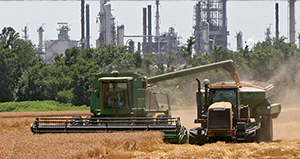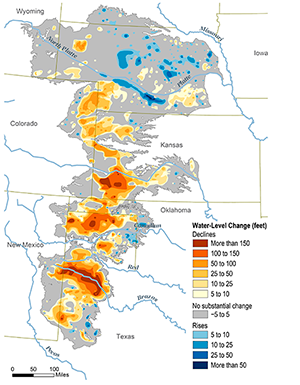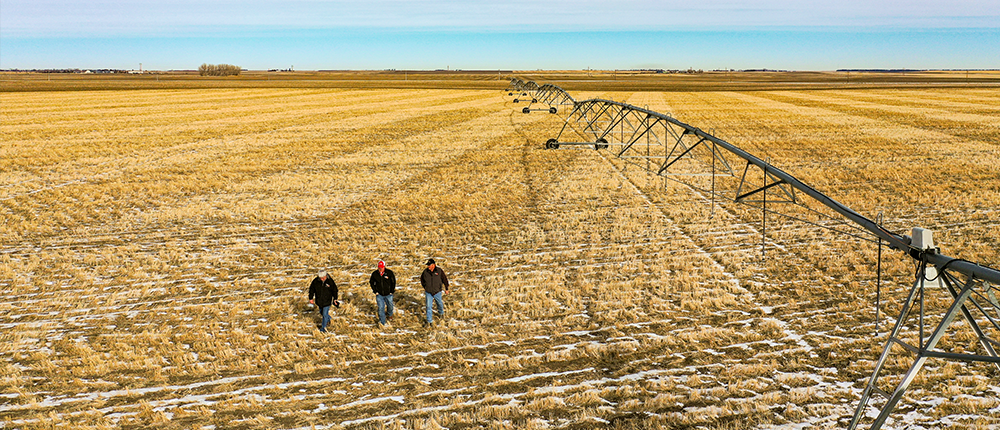![]()
Drought Trackers: Climate researchers use technology to track drought threats

Aquifer Allies: CHS refinery reduces water use to protect aquifer

River Issues Rise: Weather extremes disrupt input and grain movement on U.S. rivers
Waterways in Need: CHS advocates for waterway infrastructure funding and maintenance
Average annual rainfall around Hemingford, Neb., is 16 inches. Last season, many acres in the Nebraska Panhandle saw only 10 inches of precipitation.
“Despite that, we managed to produce some fairly good dryland crops,” says Chris Cullan. “We had good moisture early in the season and benefited from carryover moisture from the wet fall in 2019.”
Keeping water use on the farm’s irrigated acres within the five-year allocation of 65 inches can be challenging, he says. “Last season, a few pivots went over the 13-inch yearly average allotment.”
Cullan is thankful the three growing seasons just before 2020 delivered better-than-average rainfalls. “Those years we only needed to use 2 to 3 inches of water on some fields throughout the growing season, which helps balance our five-year average use."
Lower aquifer levels
In Nebraska and much of the western U.S., water use from aquifers is a growing concern. Overall, water demand has been pumping out gallons faster than rain and snowmelt can replenish them. Within 50 years, many regions could see freshwater supplies reduced by one-third, according to U.S. Forest Service projections.
That’s a sobering trend, but it’s one Cullan and other Great Plains farmers and ranchers have been dealing with for years, as Ogallala Aquifer levels decline. One of the world’s largest freshwater aquifers, it lies under a 174,000-square-mile area stretching from southern South Dakota to western Texas and supplies water for almost 30% of the irrigated crops and livestock in the U.S.
Retaining soil moisture
Nebraska leads the nation in irrigation acres. While farmers there have always looked for ways to reduce water use and related costs, changing weather patterns and long-term climate predictions are driving more farm management decisions.
Cullan has always focused on maximizing soil moisture in the cropping operation he runs with his cousin Tom Cullan. With about 60% of their acres in dryland production, a crop rotation that maximizes residue is a key element in maximizing moisture.
“Our dryland acres are now mostly no-till, so we’re used to planting into stubble,” he says. “Corn is planted into wheat stubble and the next year sunflowers are seeded into cornstalk stubble.”
Sugarbeets, alfalfa, edible beans and corn are planted in rotation on irrigated acres, along with certified wheat seed. “We produced nine varieties of wheat seed last year, which we process at our cleaning and conditioning facility, then sell to ag retailers and other farmers,” Cullan says. “Some varieties are better suited to irrigation, while others are intended for dryland use, but every variety we produce is chosen to fit local growing conditions.”
With declining freshwater suppliers, Nebraska growers and cooperatives work together to get more from every drop.
Cover crops catch on
Because wheat requires significantly less water than most row crops, its popularity in the state tends to ebb and flow with yearly rainfall, says Jim Hutchinson, sales agronomist for Farmer’s Co-op Elevator.Company at Hemingford, Neb., who works with the Cullans. “In years with more rain, many growers tend to plant less wheat and more acres of row crops. When it’s dry, more wheat is planted, like we saw last fall.”
Ogallala Aquifer levels declining
Strategic dryland and irrigation management and precision irrigation technologies are helping growers adjust for drought conditions and related crop stress, but water levels in the Ogallala Aquifer remain a concern. The map below shows changes from the time before the aquifer was tapped to 2015.

Click the image for a full size version
Planting winter wheat as a cover crop, often after sugarbeet harvest, has become more common in the area, Cullan says, and growers who manage cattle are experimenting with planting a cover crop of turnips that can later be grazed.
“Cover crops, including turnips and ryegrass, are definitely being talked about by more growers around here,” adds Hutchinson. “They help preserve soil moisture, improve tilth and reduce wind erosion. Currently, less than 20% of growers here use cover crops, but I expect that to increase.”
In Nebraska, wind erosion is often a bigger problem than water erosion, so ground cover in the form of cover crops or crop residue is essential, notes Cullan. “We’re always only one week away from a drought.”
For many growers in the region, the 2012 drought was an agronomic turning point. A multibillion dollar agricultural disaster, that year’s ultra-dry summer was compounded by temperatures topping 100 degrees Fahrenheit on 37 days in southwestern Nebraska.
“After that season, farmers started to focus on drought tolerance when choosing dryland corn hybrids,” says Cullan. “It’s not the number one trait for many growers, but it’s higher on the list.”
The cousins have been working with Hutchinson to fine-tune planting populations for dryland crops, cutting corn populations to between 9,000 and 15,000 seeds per acre to maximize yields and profitability.
Using wireless technologies and apps on their phones, the Cullans closely monitor water use on each pivot and say they’re willing to consider adding new irrigation technologies that will pencil out.
“We do what we can to minimize water use and make the most of the water we do use.”
Check out the full C magazine with this article and more.





